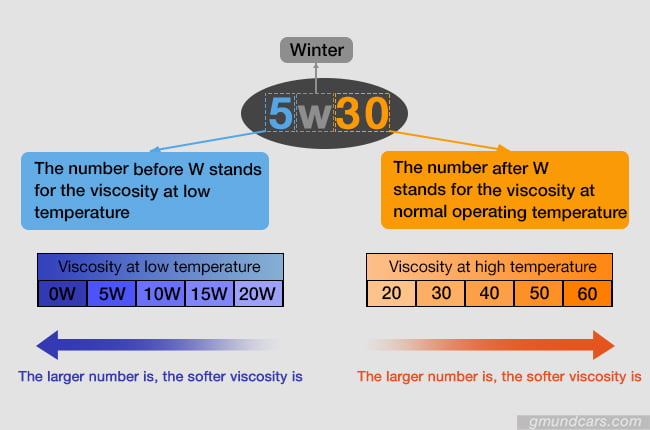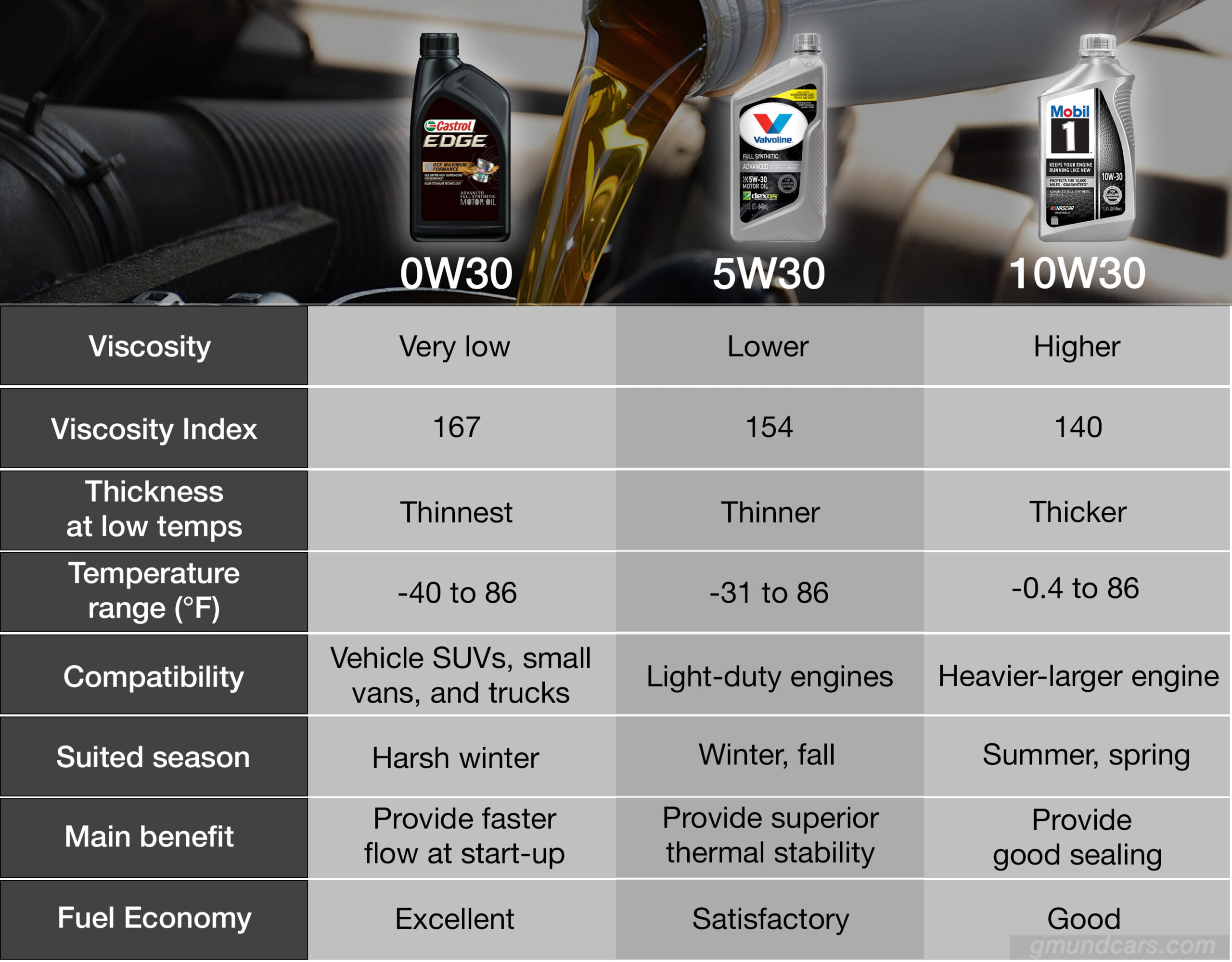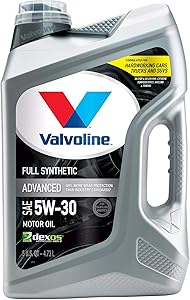The realm of motor oil often raises a variety of queries that can lead to confusion. The frequently asked question, “What’s the difference between 0w30 vs. 5w30 vs. 10w30?” is one such instance.
I must say it’s very essential to compare oil specifications and grades to know which one fits your car. But how to compare them?
Well, in this article I will help you figure out this problem by the comparison between 0w30 vs. 5w30 vs. 10w30 and give you the best recommendations for this summer!
Let’s get the ball rolling!
Basic oil numbers
Viscosity grade
When you take a bottle of motor oil, you might see something like SAE 0W30 or 5W20. What do they mean?
In motor oil, the W stands for winter. The number before W refers to the oil viscosity at low temperatures 0℉ (18℃). If this number is low, it means your oil is thin. Thin oils will help engines start quickly at low temps because they are less prone to thickening in such cold conditions. That’s why this type of oil is recommended to use in winter.
The number after W describes the thickness of the oil at the normal operating temperature. The larger this number, the higher the viscosity and thicker the fluid in hot weather. For thick oils, they are less prone to thinning in hot temps and better at maintaining film strength, so they help vehicles perform well during summer. If you live in tropical areas, you will need this number to be high since this means the oil is thick.

When you check your car owner’s manual, you will see the oil viscosity grade to use for your vehicle. However, sometimes, this will not be true because the manufacturers do not always take into account where you are living, hot climates, or cold regions. Therefore, it’s important to understand the various types of oil to use in each condition.
Viscosity index
Viscosity index (VI) is a number that represents how the viscosity changes due to temperatures. The greater the VI, the less viscosity is affected by changes in temperature.
Thus, a lubricant with a low VI will be more affected by temps change. In contrast, fluid with a high number will experience a small swing in viscosity when temps change.
What do they have in common?
Multigrade oil
The three motor fluids are multigrade oils. Multigrade oils are motor oils that can be used in a wide range of temperatures. These oils not only flow at low temperatures but also can lubricate the engine at high temperatures reliably.
For example, in the case of 0w30, 0W is the first grade that shows the oil’s viscosity when it is cold. 30 is the second grade that indicates the fluid’s viscosity in hot conditions.
“30”
As you can see, the 0W30, 5W30, and 10W30 all have “30” as the second viscosity grade. What does this number mean? This means they have a similar SAE rating at normal operating temperature.
Oils in a temperature range like this are suitable for today’s high-tech small clearance engines. They are commonly better in protecting engine components which result in a longer lifespan. The W30 fluids are also more fuel economical than higher grades. Besides, they work fine with a lot of vehicles with different engine types.
What makes them different?
Comparison table
| 0W30 | 5W30 | 10W30 | |
|---|---|---|---|
| Recommendation |  Castrol - 152B99-6PK 06244 Edge A3/B4 0W30 |  Valvoline Advanced Full Synthetic 5W-30 |  Mobil 1 120762 Synthetic 10W-30 |
| Viscosity | Very low | Low | High |
| Viscosity index | 167 | 154 | 140 |
| Effectiveness at low temperature | Thinnest | Thinner | Thicker |
| Temperature range (℉) | -40 to 86 | -31 to 86 | -0.4 to 86 |
| Compatibility | - Vehicle SUVs - Small vans - Trucks | - Light-duty engines | - Heavy-duty engines |
| Suited season | Extremely cold winter | Winter, fall | Summer, spring |
| Fuel Economy | Best | Good | Average |
| Main benefit | Provide faster flow at start-up to reach critical engine parts | Provide superior thermal stability | Provide good sealing |
Viscosity grade
In general, 0W30 has the lowest viscosity among the three. 10W30 stands at the highest position, and, of course, 5W30 is in the middle. But, what does this mean?
0W30 has a lower viscosity than other types and will flow more freely in extremely cold weather -22℉ (-30℃) or lower.
Standing in the middle of this comparison, 5W30 has a higher viscosity than 0W30 but lower than 10W30. This means it will have a free flow at a lower temperature compared to 10W30. However, it will be thicker than 0W30 at higher temperatures.
The oldest brother in the “W30” family, 10W30! This oil type is thicker than 0W30 and 5W30 at lower temperatures. It indicates 10W30 won’t flow freely like the other two when it is cold. However, when the weather is hot, this big brother will steal the show. Do you know why? It won’t bow down to heat like the others.
When to use?
Viscosity grade is one of the most important factors that affect the compatibility or application of these 3 oil types. Let’s see when to use them!
For harsh winter – 0W30
The 0W30 oil will work faster and better in freezing weathers, below -22℉ (-30℃). Do you know why? Its lower viscosity makes the oil circulate quickly around the engine immediately after ignition. So, your car’s gliding surfaces and moving parts warm up quickly during extremely cold temperatures. That’s why this lubricant is designed for vehicles in icy winter.
If you live in extremely cold regions like Michigan or pretty much all of Canada, this 0w30 is best suited.
For chilly winter – 5W30
On the other hand, 5W30 is best used in a cold climate. You need an oil that is not going to be thicker when the temperature reduces during warm weather. Also, you need one that will not be thinner when the temperature increases during cold weather.
This oil type fits into the shoe. In cold climates, it will not be too thick like 10W30. So, it flows freely. Also, in warm temperatures, it will not be too thin like 0W30. So, it develops consistent lubricating film and reduces wears. These features make this lubricant suitable for fall and winter.
For sunny summer – 10W30
10w30, undoubtedly, is the best suited for this summer. It is thicker than the others. During hot weather, this oil type won’t break down easily like the other two fluids. It still maintains enough viscosity and flows effortlessly to protect bearings and piston skirts in hot conditions. The high-temperature stability makes it a better choice for serious high-performance engines.
Fuel economy
- In this comparison battle, 0w30 will be the winner because the flowability of an oil often determines its ability to improve fuel economy.
- 5w30 once again will stand in the middle. It also saves fuel. But it is less than 0W30 and higher than 10W30.
- 10w30 seems to not get such praise in this battle because its effect on fuel economy is not appreciated.
Compatibility
- 0w30 – This fluid type is compatible with light trucks, gasoline-fueled passenger cars, and vans.
- 5w30 – We can use this lubricant for light-duty diesel and petrol engines and automotive gasoline engines.
- 10w30 – This lubricant is used for vehicles that haul and carry heavy loads. It is also suitable for advanced fuels like biodiesel and biofuel.
Key specifications and benefits
0w30

Castrol Edge A3/B4 0W-30 Advanced Full Synthetic
0W30 has the approval of GM, Gen2, and Dexos1. Additionally, it also meets the ACEA C2 specification.
This fluid features a balanced component, low-temperature requirement, and oxidation and thermal stability. So, it can be used in place of 5W30 or 10W30. But I suggest using it in harsh winter because it is designed for this purpose.
Besides, this fluid type contains dispersive additives that make it reduce sludges left behind in your engine.
5w30

Valvoline Advanced Full Synthetic SAE 5W-30
5W30 has superior thermal stability. It means, when the temperature varies widely, this fluid maintains its properties, unlike the other two oils.
Also, 5W reduces friction between moving parts and protects the engine from rusting because it forms a continuous layer on all engine parts. Additionally, it is designed to minimize oil consumption because a smaller amount of oil can sufficiently lubricate your engine.
In terms of specifications and approvals, the 5W30 meets Porsche, Ford, and Volkswagen oil specifications. It also gets Mercedes Benz, API SN, and ACEA approval depending on the oil brand.
10w30

Epsoak Epsom Salt
10W30 may not save fuel like the others, but it is better at retaining its viscosity under high temperatures.
Also, it provides a smoother gear and clutch operation. This makes it possible to achieve a noiseless engine. Besides, the motor oil is compatible with seal and after treatment.
The fluid meets the requirements of API SN. It also has an ACEA rating which is usually A3/B3 or A3/B4.

Recommendation
 Castrol 152B99 0W30 |  Valvoline SAE 5W30 |  Mobil 1 120762 10W30 |
|
| Customer Rating |  |  |  |
| Price |  |  |  |
| Viscosity index | 169 | 158 | 146 |
| Pros | + Reduces power-robbing friction. + Offers longer drain interval + Improves fuel economy + Ten times stronger against high-temps oil thickening +Improves oil film strength by 30%. | + Wakes sluggish warm up faster + Easy to pour with a sprout + Quality and value measure up + Excellent protection against high and low temps | + Combat deposit and sludge buildup + Excellent low-temperature capabilities + High lubrication quality + Longer oil change interval + Works good on old engines |
| Cons | - Poorly designed container. - No see-through strip and built-in extending spout on the bottle. | - The container is prone to rupturing and leaking. | - Poor packaging. - The container is prone to leaking. |
| Specifications and approvals | - API SL/CF - ACEA A3/B3 - ACEA A3/B4 - MB-Approval 229.3/229.5 - Volkswagen 505 00/ 502 00 | - SAE 5W-30 - API SN PLUS - API SN - Resource Conserving - ILSAC GF-5 - Ford WSS-M2C946-B1 | - ILSAC GF-6 standards - API CF - GM 4718M - GM 6094M |
| Compatibility | - Mercedes Benz - Volkswagen - Toyota - Subaru - Mazda - Lexus - Nissan | - Works well with leading synthetic and conventional petrol engine oils - Holden, - Ford, - Nissan, - Toyota, - Mazda, - Subaru. | - Modern gasoline-powered vehicles - High-performance turbocharged - Supercharged, multi-valve fuel injected engines found in + Passenger cars + SUVs + Light vans + Light trucks. |
0W30 – Castrol – 152B99-6PK 06244 Edge A3/B4
This advanced full synthetic 0W30 motor oil features a fluid titanium technology that reduces friction. It also protects against wear and deposits in the engine. This way, the Castrol Edge A3/B4 0W-30 ensures strength and performance. Besides, it increases your car’s fuel economy and horsepower.
Check Price at Amazon
5W30 – Valvoline Advanced Full Synthetic SAE 5W30
Valvoline SAE 5W-30 comes with superior antioxidants that prevent it from breaking down in extreme conditions. It has anti-wear additives that offer excellent protection against wear. Deposits and sludges are also reduced due to the extra detergents it features.
Check Price at Amazon
10W30 – Mobil 1 120762 Synthetic Motor Oil
The Mobil Motor Oil 10W-30 features an advanced full synthetic formula that provides wear protection and overall lubrication performance. It also enables long engine life by preventing the accumulation of sludge and deposit. Besides, the fluid comes with outstanding thermal and oxidation stability that offers reasonable viscosity control.
Check Price at Amazon
FAQs
1. Can I use 0W-30 instead of 5W-30?
Yes, you can use 0W-30 instead of 5W-30. However, you should pay attention to factors like temperature and viscosity. 0W will flow faster and better in a much colder climate because it is thinner. This is why it is the most suitable for use in the winter. Nevertheless, it will still get the job done in relatively warm temperatures where 5W is best suited. This is possible because they will both have the same viscosity when temperature increases.
2. Can I mix 0W30 and 5W30 BMW?
Yes, you can mix them together. I have done it many times. However, ensure they are both synthetic oils and meet the same specification.
3. Is it OK to use 10W30 instead of 5W30?
Yes. Both oils are 30 weight and provide the same thickness and flowability when the engine reaches its operating temperature. However, 5W30 is better in cold or cool weather. This means it may not be a good idea to use 10W instead of 5W in cold climates.
4. Is 10W30 better for high-mileage?
Sure. It will help improve oil pressure in high-mileage. The 10W30 contains additives that ensure better lubrication of older engines and can protect the seals. Also, the slightly thicker oil film protects the worn engine from bearings and slows down the wear process.
Final words
All the oils, 0W30 will work best for your car during the winter and for those living in states or countries with an extremely cold climate. 5W30 will be suitable for varying temperature conditions. It means you can use it in both warm and cold climates. Finally, 10W30 will work best if you live in tropical regions. Note that you can use the 10W during the winter, but it is only recommended for ambient temperature not exceeding -30℃.
